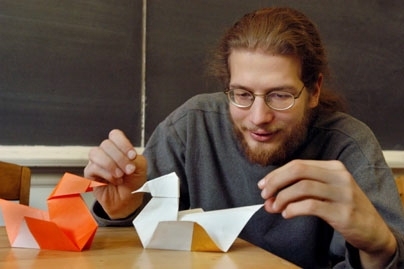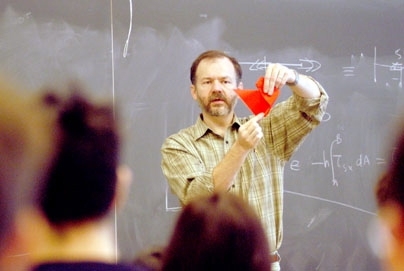True, they rattled paper throughout the 90-minute lecture, but the audience--rapt, eager, enthusiastic--hung on every word from the lips of origami master Robert Lang as he demonstrated the basics of the art and described, in a very rudimentary way, the mathematics behind it.
Lang had placed four sheets of 8.5 x 11 inch paper on all 318 seats in Kirsch Auditorium; each page had lines and dotted lines denoting crease-marks to come. Most members of the audience folded at least one of those forms while Lang talked about "From Flapping Birds to Space Telescopes: Origami, Mathematics and Art."
Lang, a former laser physicist who now does origami full-time, was at MIT to work on an algorithm for computational geometry with Erik Demaine, an assistant professor of computer science. While on campus, he gave the public lecture on Thursday, Nov. 11 and taught a beginners and an advanced origami workshop. He also taught one class in Demaine's origami course--the first one MIT has ever offered--through the Department of Electrical Engineering and Computer Science.
Although the public talk was an evening event on a mid-week holiday, the auditorium was packed, overflowing even, thanks to an article about Lang that appeared in the Boston Globe that day.
Jon Madison of Newton, a neurobiologist at Massachusetts General Hospital, saw the article in the Globe and made his way across the river for Lang's talk. A novice, Madison had been working at the craft for three weeks, trying to teach his three-year-old daughter to fold farm animals. "Turned out she's not that interested, but I got hooked," said Madison, who came to hear Lang talk because he was intrigued "by the idea that you can apply mathematics to something I always thought was a game."
At least a dozen youngsters age 10 or under were present, as well as many septuagenarians and all ages in between. Neat, conservatively dressed, middle-aged couples sat beside 20-something men wearing long hair and barrettes. They leaned forward in their seats, shouted questions to Lang well before the Q-and-A period, and exclaimed "Oh my God!" and "That is so cool!" when he demonstrated the "One Cut" property.
That property, proved by Demaine and others in 1997, says that any shape or combination of shapes can be created using a single sheet of folded paper with a single, straight cut through it. Lang folded a sheet several times, cut once and unfolded it to reveal a star-shaped cutout in the center. He folded another sheet, made the cut, and unfolded it to reveal a triangle, a square and a pentagon lined up in a row. His final demonstration revealed the MIT letterform.
A second property, "Two-colorability," describes origami's property of keeping the colors in a double-sided sheet of paper separate; once folded, no two adjacent facets will have the same color. Another, the "Maekawa-Justin Condition," says that the difference in the number of mountain folds (creased downwards) and valley folds (creased upwards) in an origami sculpture will always be two.
The relationship between math and origami is symbiotic, Lang said, allowing mathematicians to use origami to prove mathematical theorems and vice versa. For instance, the "Delian Problems" had puzzled even the ancient Greeks, who couldn't trisect an angle, square the circle or double the cube using a compass and unmarked straight edge. The first two problems were solved by scientists using origami in the 1980s.
When mathematicians and computer scientists started getting involved in origami in the 1990s, the art form of creating sculpture by simple folds became more dynamic. The basic valley and mountain folds were joined by linkages, flaps, circles, rivers and molecules. For instance, Lang's model for a deer requires 16 circles, 9 rivers and solving 200 equations to create.
Lang's own models, many of which are made using the computer program he created called Treemaker, come in many shapes and sizes. His Black Forest Cuckoo Clock (folded from a single sheet of paper, unbelievably) has 216 steps, not counting repeated steps. He built a set of life-sized musicians using flaps and linkages. When the guitarist's head is pulled up, his arm moves, strumming his guitar. Similarly, the cellist moves his bow across his instrument, and the organist's arms move. Lang's forms also include sculptures with textured surfaces, such as the fish with 400 scales and the rattlesnake with 1,000 scales, each made with a single sheet of paper. "There'll never be a second one," Lang said of both of those.
The true love for many origami masters, Lang said, is the creation of extremely detailed insects, many-legged creatures whose body, antennae and legs are all folded (and folded and folded) from a single sheet of paper. "Origami seems to be peculiarly well-suited to folding insects." said Lang.
Theoretically, any shape can also be created by folding a single sheet of paper with no cuts, no tears. But, says Lang, the finished product could be microscopic, or it could be as tall as a building. The computer program lives in the realm of possibilities, not practicalities.
Still, it all comes back to a love for the art. The algorithm Demaine and Lang are perfecting for Treemaker is one that would allow the computer to show a 3-D model of a form, rather than a stick figure, based on an image of, say, a raccoon or a car. Using that stick figure or 3-D model and the fold instructions given by the computer, a master like Lang can fold just about any figure. For now, the more robust computer program would still be used for artistic origami, rather than industrial applications. Airbags are a prime example of the use of origami, or computational geometry, in industry, Lang said.
Later, near the end of the Q-and-A, one very young man asked if Lang thought there was the possibility of earning a living doing origami. "I sure hope so," said Lang, "since that's what I'm trying to do."
A version of this article appeared in MIT Tech Talk on November 17, 2004 (download PDF).









